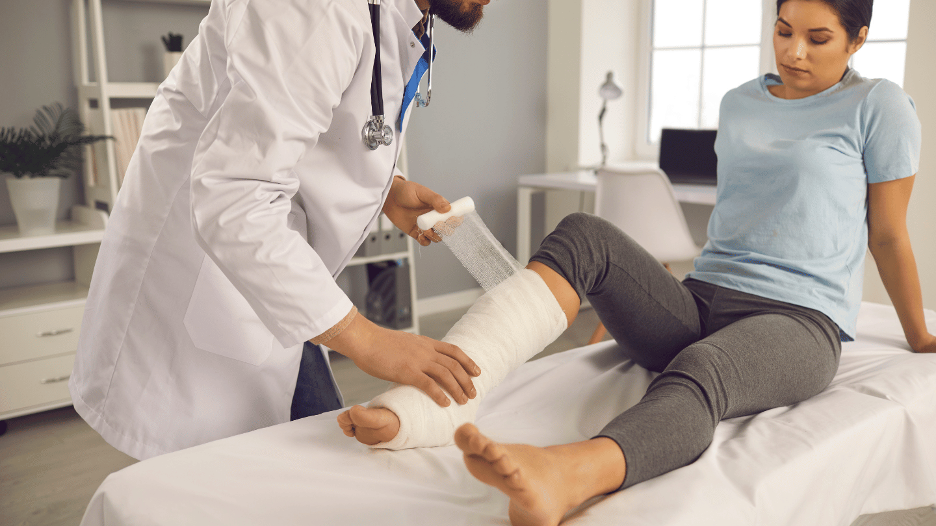
What does a stress fracture feel like? What to expect.
If you've ever experienced a stress fracture, you know it can be a subtle but serious injury. It’s one of those things that can sneak up on you, often starting as a mild discomfort and gradually becoming more intense. But what does a stress fracture feel like?
In this guide, we’ll walk you through the early warning signs, the progressive symptoms and most importantly, how to prevent and care for stress fractures.
What is a stress fracture?
A stress fracture is like a tiny crack in a bone, often caused by doing too much physical activity too quickly. It usually happens in bones that carry a lot of weight, like those in your foot or leg. If you suddenly ramp up your exercise routine or put a lot of repeated stress on a bone, it can lead to a stress fracture. It often starts with a little ache that can get worse if you don't take care of it.
Stress fracture early warning signs.
A stress fracture often begins with a faint, nagging discomfort in a specific area. Here’s what to look out for:
- Localized pain. The first sign of a stress fracture is typically a specific pain point that worsens with activity. This pain often feels like a dull ache and might be easy to ignore at first. However, 'listening to your body' means paying attention to these subtle changes and not dismissing them as normal aches and pains. This is your first clue that something might be wrong.
- Pain during physical activity. The pain may intensify as you continue your regular exercise or physical activities. Initially, you might only feel it during high-impact activities like running or jumping, but over time, it can become more persistent.
- Tenderness to touch. Another early sign is tenderness when you press on the affected area. This tenderness is usually over a bone rather than a muscle, distinguishing it from other types of injuries.
Stress fracture progressive symptoms.
If left untreated, a stress fracture can become more severe, leading to more pronounced symptoms:
- Pain at rest. One of the most telling signs that your injury has progressed is when the pain starts to linger, even when you're at rest. If you notice that the discomfort you initially felt during activity is now present even when you're not moving, it’s a strong indicator that your stress fracture is worsening.
- Swelling and bruising. As the fracture becomes more severe, you might notice some swelling or even bruising around the affected area. This occurs because the injury is causing inflammation in the surrounding tissues.
- Limited mobility. As the pain and swelling increase, you might find it difficult to move the affected limb as freely as before. This stiffness can be particularly noticeable in the morning or after periods of inactivity.
Stress fracture prevention and care.
Preventing a stress fracture is often easier than treating one. Here’s how you can take care of your bones and avoid this painful injury:
- Gradual increase in activity. If you’re starting a new exercise routine or ramping up your current one, do it gradually. Your bones need time to adapt to increased stress, so avoid sudden jumps in intensity or duration.
- Proper footwear. Wearing shoes that provide adequate support and cushioning can go a long way in preventing stress fractures, especially if you're involved in high-impact sports. Replace your shoes regularly, as worn-out soles can lead to uneven stress distribution on your bones.
- Cross-training. Incorporating low-impact activities like swimming or cycling into your routine can help reduce the stress on your bones while still keeping you fit. Cross-training also helps strengthen different muscle groups, providing better overall support for your body.
- Rest and recovery. Listen to your body—if you're feeling pain or discomfort, take a break. Adequate rest is crucial in preventing injuries, including stress fractures. Make sure you’re also getting enough sleep, as this is when your body does most of its healing. Remember, taking care of your body is a form of self-care and support.
- Seek medical attention. If you suspect you have a stress fracture, it's essential to consult a healthcare provider as soon as possible. Early diagnosis and treatment can prevent the injury from becoming more severe, reducing recovery time and preventing long-term complications.
Do stress fractures need a cast?
Not every stress fracture needs a cast, depending on its severity and location. In many cases, doctors might suggest wearing a protective boot or using crutches to take the weight off the injured area and give the bone a chance to heal.
However, if the fracture is more severe, especially in places like your foot or lower leg, a cast might be necessary to ensure everything heals correctly. Your doctor will help you figure out what’s best for you and guide you through the proper treatment.
Can I walk on a stress fracture?
Walking on a stress fracture isn’t the best idea, especially if the fracture is in a bone that bears weight, like your foot or leg. Putting pressure on the injured area can worsen the fracture, possibly leading to a break that will take longer to heal. If you think you might have a stress fracture, it’s essential to rest and avoid activities that cause pain.
Crutches or a supportive boot can help keep weight off the area while it heals. Your CityMD doctor will tell you how much weight you can safely put on your injury, so follow their advice.
When to visit CityMD.
If you're experiencing any of the symptoms mentioned above, especially if the pain persists even at rest, it’s time to seek professional help. CityMD’s urgent care services are here to provide you with a quick diagnosis and a personalized treatment plan. Don't wait until the pain becomes unbearable—visit your nearest CityMD and let our experts help you get back on your feet safely.
Stress fractures are common, but they don’t have to sideline you. By recognizing the early signs, understanding the symptoms and taking preventive measures, you can protect your bones and stay active for years to come.

We’re ready to care for you.
Visit any CityMD urgent care location in your community today for an evaluation with one of our expert providers.